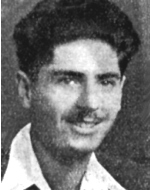Israeli, Aryeh
Son of Shoshana nee Yahalom (grandson of Rabbi Aryeh Leib Frumkin, pioneer of the renewal of the settlement in Petah Tikva during the period of the “shelter” against malaria in Moshav Yehud) and Nehemiah, was born on 23.3.1925 in Petah Tikva. He overcame childhood illnesses, and in the kindergarten he was already able to influence and lead, humor and natural grace. At the age of five and a half, he managed to get into the first parallel class of the older children and competed with them to progress in his studies. He read books a lot and at the age of 9-10 was a volunteer assistant to a librarian in the public library. His knowledge of the history of the Yishuv and its activists, and his visit to his class at the 30th anniversary of the Histadrut in Petach Tikvah, revealed that the name of one of the occupants of the place had been dropped decades ago, and the mistake was corrected in accordance with his comment. In his great knowledge of the aggadic books, he learned during the years of his studies at the Ahad Ha’am Gymnasium to quote every verse in the Bible that relates to it. During his studies, he was a counselor in the “Young Maccabi” and was a member of the Haganah and the HaChayash, and Arieh acquired a library that was rich in training and maps, traveled extensively with his students to learn about Eretz Israel and demanded great precision from himself and from them. The young Maccabee branch he left behind, and in his letters to Yaakov, his younger brother, who remained a counselor in his place, would send advice and instructions to improve the training and improve it.Then he completed his high school cum laude in 1942 and passed a government matriculation exam, For a year of service in the nucleus of the “Solelim” group of his movement in Neve Eitan, in the Beit Shean Valley, he devoted his leisure time to the school In October 1944 he was admitted to the Department of Structural Engineering at the Hebrew University of Haifa, where he coordinated activities at the “Maccabi Hamizair” branch in the city and was promoted to the rank of ” He was especially interested in water supply and irrigation arrangements, and when he finished his studies at the Technion in 1947 and was still not given a diploma, he was accepted on the basis of personal impression Good for working in the water department of the Jewish Agency Executive as a water engineer. When the War of Independence began, he was left with his work, which was also necessary to ensure the stability of distant points, and he traveled to them in spite of the dangers on the roads. Mekorot’s request to transfer it to its service for supervision of the Negev line was initially rejected by the department, which refused to give up its work. After his brother Jacob fell in battle for the Castel, he urged the platoon to release him so that he could enlist, and finally was sent as a battalion water officer to supervise the line in the Negev. He fulfilled the role with great vigor and many of his plans and demands regarding the supply of water to disconnected points, and even proposed to establish eleven new points in the places he mentioned, in order to secure the water line and the main roads. On his way to repair the water line that was detonated by the Egyptians, his car was killed on a landmine between Tze’elim and its rebirth on the 27th of Elul 5708 (27.9.1948). He was buried in Tze’elim. His diploma, the certificate of proximity to a qualified engineer, was received by his parents at a ceremony held at the Technion in March 1949. On the 15th of Iyar, May 5, 1950, he was laid to rest at the Nachlat Yitzhak military cemetery.
